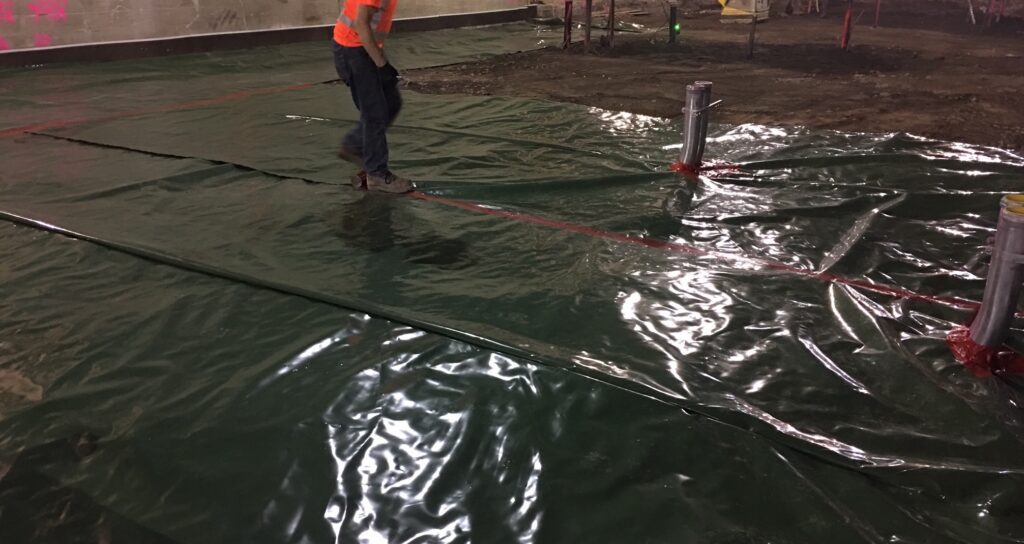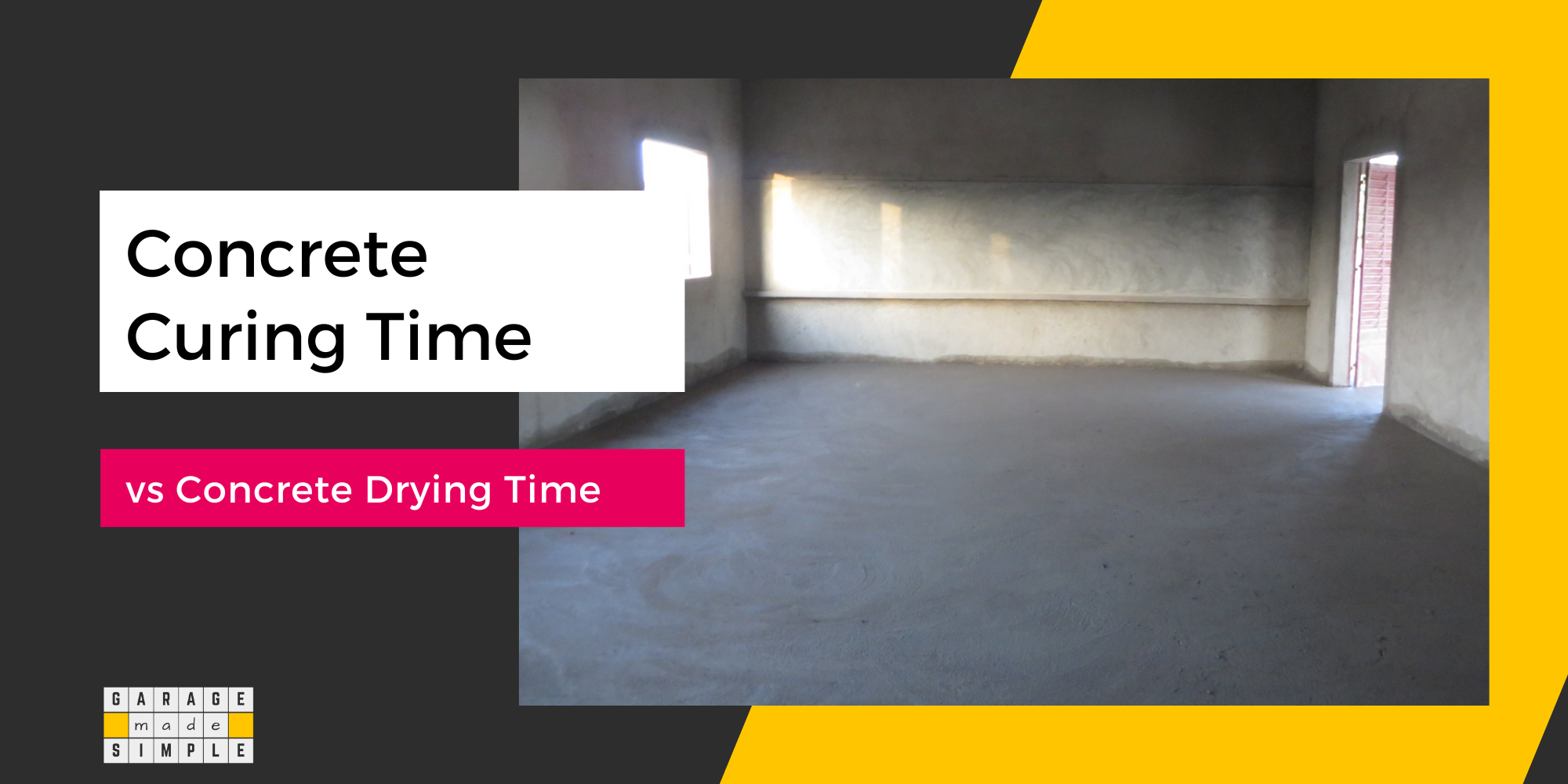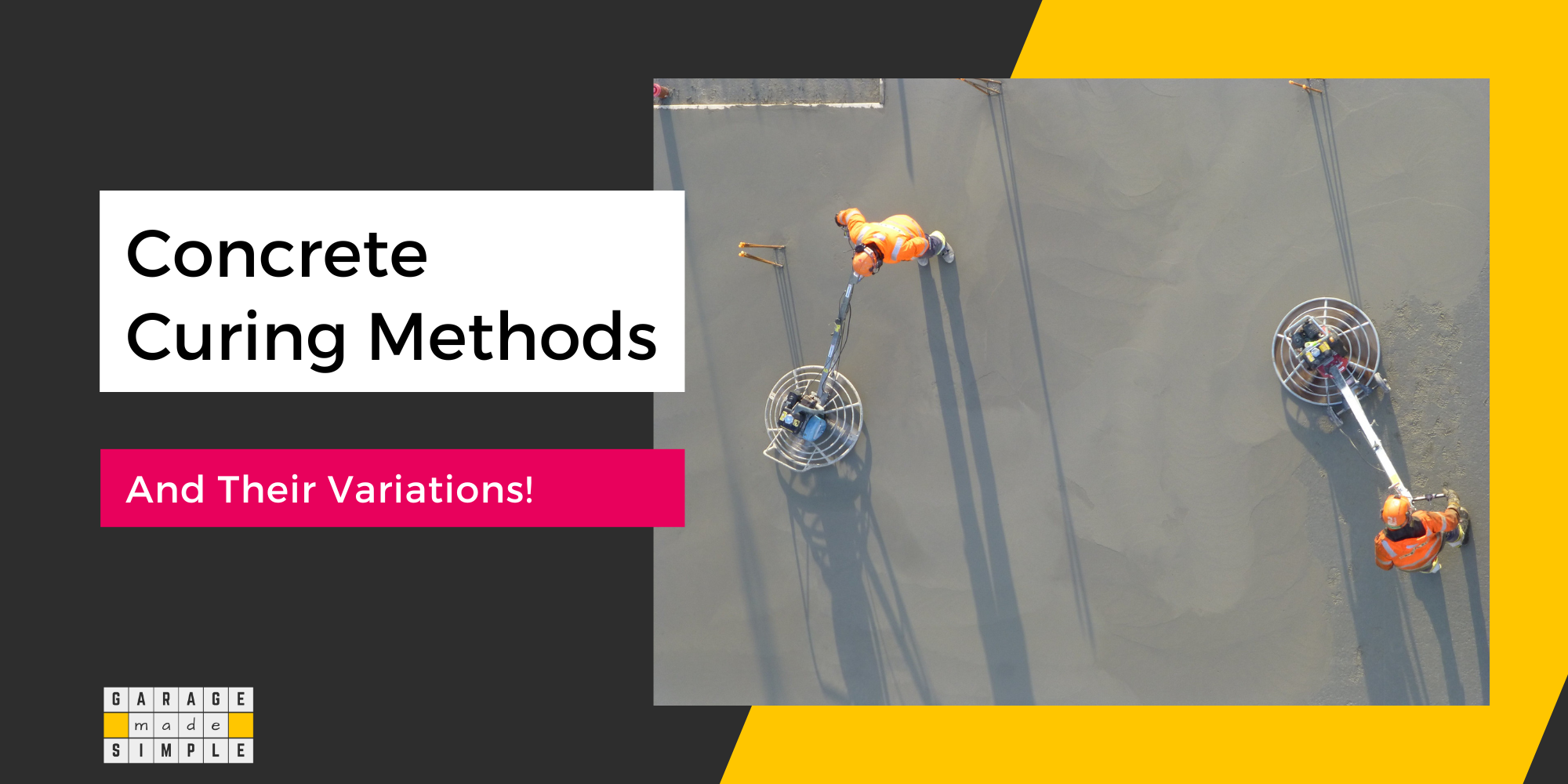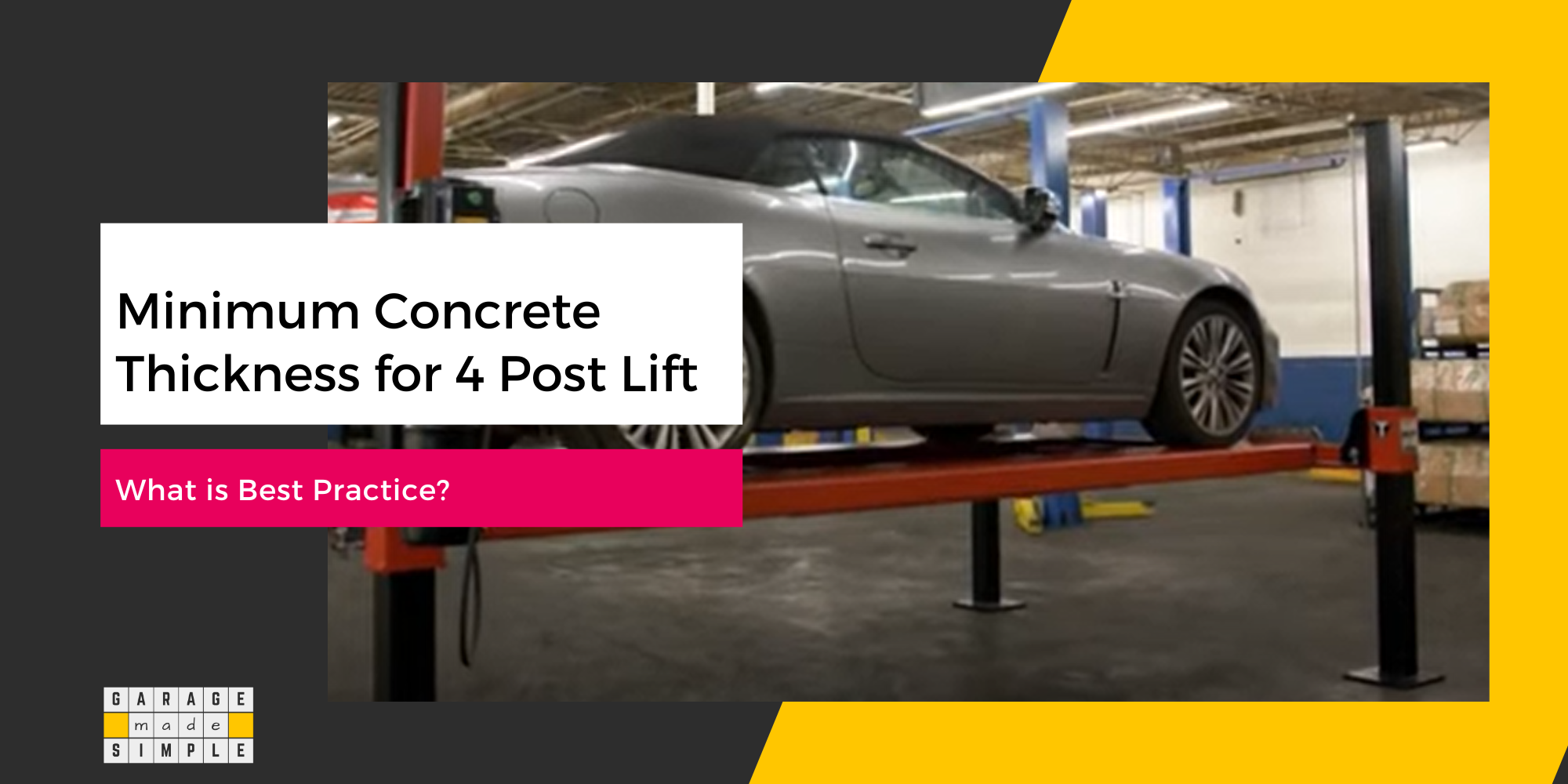A Comprehensive Guide to Vapor Barrier For Garage Floor [2024]
As an Amazon Associate, I earn from qualifying purchases.
Are you ready to pour the floor of your new garage? Don’t make the mistake even professionals often make. Do not skip the vapor barrier for the garage floor!
A vapor barrier for the garage floor is used to prevent moisture present in the grade below, from penetrating through the concrete slab. It is typically made of plastic or foil and is installed over the base and before the concrete mix is poured.
A vapor barrier plays a vital role in protecting the concrete garage floor from dampness, which can lead to mold, mildew, and structural damage.
This article is a “Comprehensive Guide” on Vapor Barrier and its use in Garage Floor construction.
Is a Vapor Barrier for Garage Floor Required?
Section R506.2.3 of the 2021 International Residential Code (IRC) requires that a minimum 10 mil vapor retarder be placed between the concrete floor slab and the soil support system or the prepared subgrade.
However, it permits exceptions for certain types of constructions such as garages, utility buildings, and other unheated accessory structures.
In essence, the vapor barrier for the garage floor is not mandated by the code. However, the use of a vapor barrier for a garage floor is an excellent practice as it will protect the floor from getting wet from the moisture in the grade below the floor.
Water ingress into the concrete slab pores is extremely damaging in the long run.
“The most destructive agent of concrete structures and components is probably water”.
Quote from Wikipedia
A vapor barrier for the garage floor adds very little to the construction cost. However, if it is not done at the construction stage, it can not be done in the future.

Solutions such as sealing or waterproofing the garage floor after the concrete slab has been poured are great for preventing moisture penetration from above but not good enough to prevent moisture wicking from the grade below.
In most climatic zones and soil conditions, the ground below the garage will have moisture. The vapor pressure will push the moisture through the concrete slab.
A vapor barrier for the garage floor is an inexpensive way to block it. But it must be done at the construction stage.
If you put it in you have nothing to worry about. If you do not, you may live to regret your decision.
TIP: It is extremely important to keep the water / cement ratio to less than 0.5 to ensure the water in the concrete mix can exit at the prescribed rate, in spite of the vapor barrier and the concrete achieves the required compressive strength.
What is the Purpose of a Vapor Barrier?
A vapor barrier is a material that prevents the movement of vapor or moisture from an area of concentration to a livable area where it can cause damage to the construction, promote mold growth, and become a health risk.
A vapor barrier may become necessary on all surfaces of a garage; namely the garage floor, walls, and roof. Without a vapor barrier for the garage floor, moisture from the wet ground will move up through the porous concrete.
The Concrete Floor
The concrete mix
“.. is about 10 to 15 percent cement, 60 to 75 percent aggregate and 15 to 20 percent water. Entrained air in many concrete mixes may also take up another 5 to 8 percent.”
Source: The Portland Cement Association
The concrete mix is a slurry and can be poured into a garage floor slab. The cement reacts with the water to form crystals. The crystals grow into a matrix enveloping the sand and other aggregates in a tight mesh.
This is the process of curing. Soft pliable concrete mix slurry transforms into a rock-hard solid material.
However, concrete, a solid rock-hard building material is actually full of holes, like a block of cheese. OK, these holes are really small. Call them pores or capillaries.
Water, which was friendly and essential in the concrete mix slurry, is now a deadly foe. It will hurt the concrete in every way it can.
- Increase the top layer of the weak cement
- Carries corrosive & harmful chemicals to the concrete interior
- Corrode reinforcing steel
- Stress the concrete as temperature fluctuates
- Get absorbed by the silica gel to put pressure
The role of the vapor barrier is to prevent outside water from penetrating the concrete garage floor and weakening it.
Types of Vapor Barriers
Vapor barriers come in various types, tailored for different applications:
- Plastic Sheeting: Typically made from polyethylene, it’s a common, cost-effective option, often used under concrete slabs and in crawl spaces to prevent ground moisture from rising.
- Foil: Aluminum foil barriers reflect radiant heat and are used in walls, roofs, and attics to insulate and block moisture.
- Asphalt-Coated Paper: Combining asphalt and paper, this barrier provides moisture resistance and added strength, commonly used in roofing and construction.
- Rubber Membranes: Durable and flexible, ideal for areas with high moisture levels, often used in foundations and basements.
- Rigid Foam Insulation: Resistant to water vapor diffusion, used in structural applications, mechanically fastened, and sealed at joints.
- Reinforced Plastics and Metals: Includes materials like aluminum and stainless steel, which are highly resistant to water vapor diffusion and are used in various construction applications.
- Foil-Backed Wallboard: Used in walls to prevent moisture diffusion, often part of the building materials.
- Paint-Like Coatings: Applied on surfaces to retard vapor diffusion, suitable for various construction needs.
- Water Resistive Barriers: These barriers, like polyethylene plastic sheets and builder’s foil, control water vapor diffusion and air movement, especially useful in southern climates.
Each type has unique properties, making it suitable for different moisture control needs in construction.
What is the Difference between Vapor Barrier and Moisture Barrier?
Vapor barrier and moisture barrier are essentially the same thing. The correct terminology is “vapor diffusion retarder”.
Permeability is the property of a construction material that allows water vapor to pass from one side to the other. This is measured in units called “perms”.
The lower the perm, the lower the permeability of the material, and the higher its ability to retard the diffusion of vapor.
Correct Placement of Vapor Barrier Under a Concrete Slab
For maximum effectiveness, the vapor barrier should be in direct contact with the underside of the concrete slab.
This means that the vapor barrier should be laid out after all the ground preparation has been completed. Smooth out the base with a thin layer of sand, if required so that there is no risk of the vapor barrier being punctured by sharp rock or gravel.
The vapor barrier must be protected before the pouring. A few tips:
- Run the vapor barrier up onto the footing or foundation wall.
- Never punch holes in the vapor barrier.
- Ensure seams overlap and are sealed with tape.
A vapor barrier with holes or cuts is not a vapor barrier anymore!
The concrete mix should then be poured directly onto the vapor barrier.
Experience has shown, however, that the greatest level of protection for floor coverings, coatings, or building environments is provided when the vapor retarder/barrier is placed in direct contact with the slab.
ACI 302.1R-15 Section 5.2.3.2 Vapor retarder/barrier location
Vapor Barrier or Vapor Retarder Classification
Polyethylene or Polyolefin sheets are generally used as a vapor barrier for concrete slabs.
However, The International Residential Code (IRC) classifies materials by their permeability. Vapor retarder materials are categorized into one of three types:
Class I vapor retarders (0.1 perms or less):
- Sheet metal.
- Polyethylene sheet.
- Rubber membrane.
Class II vapor retarders (greater than 0.1 perms and less than or equal to 1.0 perms):
- Unfaced expanded or extruded polystyrene.
- Thirty-pound asphalt-coated paper.
- Bitumen-coated Kraft paper.
Class III vapor retarders (greater than 1.0 perms and less than or equal to 10 perms):
- Gypsum board.
- Fiberglass insulation (unfaced).
- Cellulose insulation.
- Board lumber.
- Concrete block.
- Fifteen-pound asphalt-coated paper.
- House wrap.
(Source: U.S. Department of Energy.)
Vapor barriers are usually sheets or membranes. But they can also come as liquid polymers which dry up to form a vapor retarding film. Liquid vapor barriers are useful in repair or waterproofing post-construction.
Can I Use Plastic Sheeting as a Vapor Barrier?
Polyethylene sheets, which are in generic terms plastic sheets, are what are commonly used as a vapor barrier for concrete slabs.
So yes plastic sheeting can be used as a vapor barrier for the garage floor but to really work it must conform to the recommended specifications.
Any plastic vapor retarder/barrier material to be used below slabs should be in full compliance with the minimum requirements of ASTM E1745 and the thickness and permeance of the material be selected on the basis of protective needs and durability during and after installation
ACI 302.1R-15 Section 5.2.3.1 Vapor retarder/barrier location
As a thumb rule, a plastic sheet should be good enough as a vapor barrier for a garage floor, if it is at least 10 mils thick and has a “perm” of 0.1 or less.
What Happens with a Double Vapor Barrier?
Using a double vapor barrier layer under a concrete slab does not help. It may actually be harmful!
When it comes to vapor barriers, what matters is the “perm” and the thickness.
Two layers of vapor barrier, each 6 mil thick is worse than one layer of vapor barrier which is 10 mil thick. This is because:
- Two layers can trap moisture between them.
- A 6 mil vapor barrier is more likely to rupture during construction.
In fact, the old practice & recommendation of using a 6 mil vapor barrier was revised to 10 mil, mainly because of frequent rupturing of the 6 mil vapor barrier during construction.
Why is my Garage Floor Always Wet?
You may have heard your friends or neighbors ask this question. A garage floor gets wet from water either from below or from above.
The groundwater can move through the concrete floor through a phenomenon known as capillary action. Water can also be deposited on the garage concrete floor through another phenomenon known as condensation.
Capillary Action
Capillary action, also called capillarity or simply wicking is a result of two forces, cohesive and adhesive.
Both are intermolecular forces and can overcome the opposing gravitational force in a capillary (a narrow tube). Water will rise till the upward capillary action is balanced by the downward gravitational force.
“Capillarity is the result of surface, or interfacial, forces. The rise of water in a thin tube inserted in water is caused by forces of attraction between the molecules of water and the glass walls and among the molecules of water themselves. The narrower the bore of the capillary tube, the higher the water rises.”
Source : Brittanica
The first reason your garage floor may be wet is because the groundwater is wicking up through the porous concrete, much like liquid wax on a candle wick. Cracks in the concrete floor can only make the situation worse!
Condensation
Condensation is the process of water changing back from a gas (water vapor) to liquid water.
“Condensation is the process where water vapor becomes liquid. It is the reverse of evaporation, where liquid water becomes a vapor. Condensation happens one of two ways: Either the air is cooled to its dew point or it becomes so saturated with water vapor that it cannot hold any more water.”
Source: National Geographic
Evaporation is one part of the water cycle. Condensation is the other.
Evaporation is the process of water changing its state from liquid to gas (vapor) and entering the atmosphere. Condensation is the reverse.
In nature, condensation is the phenomenon that creates mist, dew drops, and rain. If it is really cold the water even freezes into snow or ice.
The second reason your garage floor may be wet is humid air releasing its moisture, much like dew drops on a grass lawn.
Should you want to know more, check out my earlier blog post How To Make Sure Of No More Damp Garage Floors
How to Check for Moisture in a Concrete Floor?
Actually, the way to check for moisture in your garage floor is rather simple. It requires nothing more than a piece of polyethylene sheet and some duct tape.
Cut a one-foot or two feet square of the polyethylene sheet. The bigger the better. Lay this flat on your concrete garage floor. Smoothen it out to ensure there is little or no air between the sheet and the floor. Then tape all four sides to the floor using duct tape or similar.
Do this sometime in the evening. Check it out next morning.
First, check the top side of the plastic sheet. Is it wet? If yes, then there is condensation. If not, condensation is not the problem.
Next, rip the plastic sheet off the floor and check the underside. Is it wet? If yes, then your garage floor is wet because groundwater is wicking up through the porous concrete.
In this case, you may also find that the floor color under the sheet is a darker grey as compared to the surrounding area. That is because the moisture was trapped under the plastic sheet overnight.
If you want to measure the moisture level in the garage floor you will have to use a moisture meter. There are quite a few models available, some even costing $300-$400.
But you do not need to spend such a large sum of money. Extech MO55 – Combination Pin/Pinless Moisture Meter works just fine and is reasonably priced. It can be used to measure Moisture Levels in wood, wallboard, sheetrock, cardboard, concrete, plaster, and mortar.
How do I Keep Moisture out of my Garage Floor?
You need to find out the real cause of moisture in and on your garage floor and then take the appropriate preventive and/or corrective action.
Capillary Action
If the moisture is creeping into your garage floor through the porous concrete slab then you should have put in a vapor barrier at the time of pouring the slab. You have either not done it or the vapor barrier for the garage floor is not performing to specification.
You can still take some corrective measures. Sealing the concrete garage floor will help. You may also want to use above floor vapor barrier for the garage floor before laying down any Vinyl Tiles or other garage floor covering.
They will not solve all the problems but will solve some and be helpful.
Condensation
To reduce or eliminate moisture on the floor due to condensation you will need to upgrade your garage to be climate controlled. Basically, this means that you will have to use dehumidifiers to control humidity and heating to ensure the garage floor does not go below the dew point.
Water Diverter
Implement Best Garage Drain Solutions to reduce water pooling on the garage floor. Containment mats for parking cars, especially during rain & snow are helpful. Garage Floor Water Diverter Is Helpful in keeping the garage floor dry when the outside is flooded.
Thank you very much for reading the post. I do hope you found it informative and useful.






